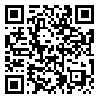BibTeX | RIS | EndNote | Medlars | ProCite | Reference Manager | RefWorks
Send citation to:
URL: http://journal.bums.ac.ir/article-1-2037-en.html
2- Dept. of Sport Physiology, School of Physical Education and Sport Sciences, Shiraz University, Shiraz, Iran.
3- Dept. of Anesthesiology and Intensive Care, Fasa University of Medical Sciences, Fasa, Iran & Noncommunicable diseasea research center, Fasa University of Medical Sciences, Fasa, Iran.
4- Dept. of Sport Physiology, Faculty of Physical Education and Sport Sciences, Bu-Ali Sina University, Hamedan, Iran.
Background and Aim: Osteoporosis is a metabolic bone disease that can result from cytokines activity such as TNFɑ. The aim of this study was to evaluate the effect of pulsed electromagnet therapy on femoral strength and bone microstructure in ovariectomized rats.
Materials and Methods: In this experimental study, 30 rats were randomly divided into control, experimental1 (ovariectomized) and two experimental groups; namely ovariectomized and undergoing pulsed electromagnet groups. The control and experimental1 groups were kept under controlled conditions, while the two experimental groups were treated with pulsed electromagnet (2.4 mT) from 12 postoperative weeks for 30min, 3days a week, for 10 weeks. Then, the subjects were sacrificed and their femoral bones were removed to determine the strength and the bone microstructure parameters (the trabecular and cortical thicknesses and trabecular distances). In order to determine bone microstructures, the sections were prepared and stained with H&E. Then, Haworth method was used to measure. One-way ANOVA, repeated measurements, and Scheffe post- hoc tests were applied to analyze the obtained data. Statistical analyses were performed using SPSS software (version 16; Chicago,IL).
Results: Despite equal initial weight of the subjects (P=0.15), they significantly gained weight after12 and also 22 postoperative weeks (P<,0.001). Cortical and trabecular thicknesses, and femoral strength respectively and significantly decreased in the experimental group 1 .X=220.80±5.90,P<0.001; X=90.34±5.73,P=0.001; X=5.15±1.07,P=0.002. In the experiment. group 2, decrease was .X=255.40±6.02,P<0.001; X=113.50±3.43, P=0.008; X=8.00±1.11,P=0.015; respectively, comparing with the control group (X=232.36±5.13, X=100.50±5.06, X=6.95±1.16). Cortical and trabecular thicknesses, and bone strength significantly increased in the experimental group 2, compared to the experimental group 1(P<0.001). There was also a significant decrease in the trabecular distance in the experimental group 2 (X=111.60±2.87) compared to the experimental 1 (X=127.40±4.74, P<0.001).
Conclusion: Pulsed electromagnet, can be effective on the osteoporosis improvement.
Received: 2016/02/4 | Accepted: 2016/07/11 | ePublished: 2016/08/31
| Rights and permissions | |
 |
This work is licensed under a Creative Commons Attribution-NonCommercial 4.0 International License. |





